Emergency kittens
Here’s a bookmarklet that replaces all the images on a page with kittens. To use, just drag it to your bookmarks bar and click when necessary.
Update: I’ve edited the bookmarklet to work around an issue at placekitten.com. The kittens are now black & white only, but otherwise it’s working again. Possibly.
Inside Insides
Inside Insides is building a collection of animated MRI scans of foods. It doesn’t sound all that fascinating, but take a look at this:
That’s a head of broccoli. You’ll never guess what this next one is:
Give up? Apparently it’s a banana flower. There are loads more of these at http://insideinsides.blogspot.co.uk/.
Stealth monitor
Here’s a clever idea — strip the polarizing filter away from a computer monitor and turn it into a pair of polarizing sunglasses. When you look at the screen through the sunglasses, it will appear perfectly normal. Everyone else will just see a blank white space.
Solution to GCHQ competition
Note:
The domain that hosted this competition appears to have been taken over by malware pushers, and the pages hosted on other sites around the web have all been deleted. Where possible, I have replaced the links in this article to pages stored at the Internet Archive. The archived home page of this competition can be seen here.
Stage 1
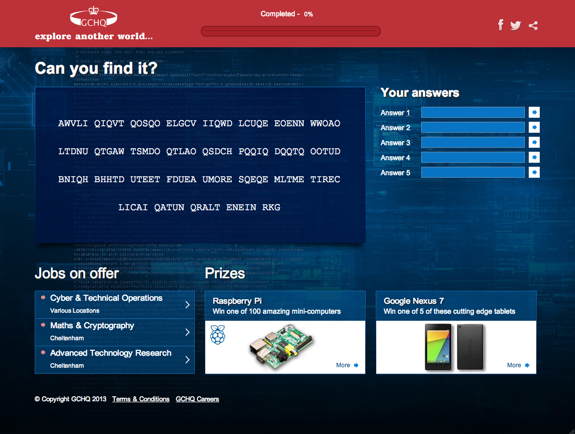
The first thing you see on the competition page is the following code:
AWVLI QIQVT QOSQO ELGCV IIQWD LCUQE EOENN WWOAO LTDNU QTGAW TSMDO QTLAO QSDCH PQQIQ DQQTQ OOTUD BNIQH BHHTD UTEET FDUEA UMORE SQEQE MLTME TIREC LICAI QATUN QRALT ENEIN RKG
This is a simple transposition cipher. When arranged in 11 lines of 13 characters, the message appears in the columns from left to right:
A W V L I Q I Q V T Q O S Q O E L G C V I I Q W D L C U Q E E O E N N W W O A O L T D N U Q T G A W T S M D O Q T L A O Q S D C H P Q Q I Q D Q Q T Q O O T U D B N I Q H B H H T D U T E E T F D U E A U M O R E S Q E Q E M L T M E T I R E C L I C A I Q A T U N Q R A L T E N E I N R K G
This reveals the URL www.metro.co.uk/turing, which is the location of stage 2.
The answer to stage 1 is the tail end of this URL: turing
Stage 2
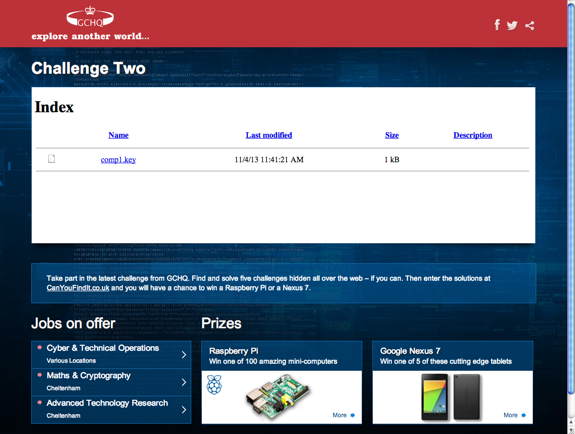
At stage 2, you are presented with a link to a private encryption key. Opening the file in a text editor shows its contents to be as follows
-----BEGIN RSA PRIVATE KEY----- MIIC2gIBAAKBgDfABK8+joDLdbFTDJ+y3PTTzkqCi1L2qEjgxdg1iyZshJTeKUck SYVyKBeOBtB3FwwqXVa6iNEHJeLFewFE6ulEOIcatVp11Zg0ibMfnqTivbd6t8/z 3KzqrFksg9xQiicMactmTqFkm8ro5ODc2NTQzMjEwLy4tLCslBOCOVHxAgMBAAEC gYATW12FB2BtQbecmSxh6rWjYENZRZhgdvoZS8oF9xlYfwdNtRF5/RR1/BwFia++ BAuBktgTu/KzORsjcNPzrd0uTCbTG6hW8YPK2ROVOOeAMHek8Nl3+SW5wdePKuWw MdjDDjqxXDns+ZC1d2Cpz5V+x+2znOYL0bsEKei0sWl7LQKBgDfABK8+joDLdbFT DJ+y3PTTzkqCi1L2qEjgxdg1iyZshJTeKUckSYVyKBeOBtB3FwwqXVa6iNEHJeLF ewFE6uhVSior5HGPArFhsOQ0v9ob1NCV7P8M99qN4XplmX/xs05HgQCVh9aMWtio pKCcmJSQjIiEgHx4dHBsU9JB+TvkAkB3dy53aHRzaXNpbGd1b2VjdHNyZWhzcmku ZW9jdS4va2xidGVoY2VsIHkgICAgICAgICAgICAgICAgICAgIAuPAkATpSSd/C5S IEAbUPk+ZYAdt7OYVzay7ViAiaukhkt+/sJG+m8GmHnAKyLf9ohx3/aIcd/2iHHf 9ohx3/ayirJPAkAIefJYEpdAoRjJQCHPGUpOVjLiyQMyPcnsutG+ctAGGU8lZTDU yUim9V7iwqTE4sKkxOLCpMTiwqTE4sKkxOFNAoGAFInzTsAOkauW3crd1XfxMhxi tUkapdQqlwvFhZuouNIybfEOfW6WkjtghBDyqf50cEFWXMJ7Vk8mr6cwTosPvYKU VXKUCblretLTeU95TlbkprizPky++5b7pQuSi3mpLMi+6VgvcjTthfXPYNg2JjJp gmteC4felYL/2FTAmT8= -----END RSA PRIVATE KEY-----
After running the contents of this file through binhex and hexdump utilities, it’s possible to see a bit of plain text in the middle of the data:
... 0190: d2 41 f9 3b e4 02 40 77 77 2e 77 68 74 73 69 73 .A.;..@ww.whtsis 01a0: 69 6c 67 75 6f 65 63 74 73 72 65 68 73 72 69 2e ilguoectsrehsri. 01b0: 65 6f 63 75 2e 2f 6b 6c 62 74 65 68 63 65 6c 20 eocu./klbtehcel 01c0: 79 20 20 20 20 20 20 20 20 20 20 20 20 20 20 20 y 01d0: 20 20 20 20 20 0b 8f 02 40 13 a5 24 9d fc 2e 52 ...@..$...R ...
After switching around each pair of letters (some sort of endianness issue, perhaps?), we obtain the URL www.thisisgloucestershire.co.uk/bletchley.
Stage 2 answer: bletchley
Stage 3
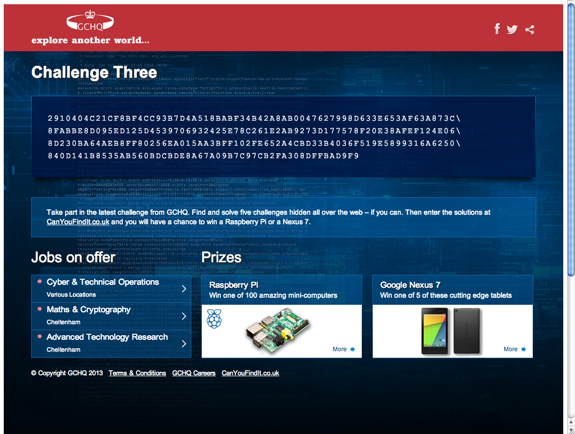
For stage 3, all we are given is a 128-byte hexadecimal number:
2910404C21CF8BF4CC93B7D4A518BABF34B42A8AB0047627998D633E653AF63A873C\ 8FABBE8D095ED125D4539706932425E78C261E2AB9273D177578F20E38AFEF124E06\ 8D230BA64AEB8FF80256EA015AA3BFF102FE652A4CBD33B4036F519E5899316A6250\ 840D141B8535AB560BDCBDE8A67A09B7C97CB2FA308DFFBAD9F9
It appears that this has to be decrypted using the private key from stage 2. But OpenSSL refuses to do this:
$ openssl rsautl -decrypt -in level3.bin -inkey comp1.key -out level3.txt RSA operation error 2685662596:error:0306E06C:bignum routines:BN_mod_inverse:no inverse:bn_gcd.c:491:
The error messages from OpenSSL aren’t very clear, but the reason why it’s refusing to work is because the private key is invalid:
$ openssl rsa -in comp1.key -check RSA key error: p not prime RSA key error: n does not equal p q RSA key error: d e not congruent to 1 RSA key error: dmp1 not congruent to d
So let’s take a closer look at this private key:
$ openssl rsa -in comp1.key -text -noout
Private-Key: (1022 bit)
modulus:
37:c0:04:af:3e:8e:80:cb:75:b1:53:0c:9f:b2:dc:
f4:d3:ce:4a:82:8b:52:f6:a8:48:e0:c5:d8:35:8b:
26:6c:84:94:de:29:47:24:49:85:72:28:17:8e:06:
d0:77:17:0c:2a:5d:56:ba:88:d1:07:25:e2:c5:7b:
01:44:ea:e9:44:38:87:1a:b5:5a:75:d5:98:34:89:
b3:1f:9e:a4:e2:bd:b7:7a:b7:cf:f3:dc:ac:ea:ac:
59:2c:83:dc:50:8a:27:0c:69:cb:66:4e:a1:64:9b:
ca:e8:e4:e0:dc:d8:d4:d0:cc:c8:c4:c0:bc:b8:b4:
b0:ac:94:13:82:39:51:f1
publicExponent: 65537 (0x10001)
privateExponent:
13:5b:5d:85:07:60:6d:41:b7:9c:99:2c:61:ea:b5:
a3:60:43:59:45:98:60:76:fa:19:4b:ca:05:f7:19:
58:7f:07:4d:b5:11:79:fd:14:75:fc:1c:05:89:af:
be:04:0b:81:92:d8:13:bb:f2:b3:39:1b:23:70:d3:
f3:ad:dd:2e:4c:26:d3:1b:a8:56:f1:83:ca:d9:13:
95:38:e7:80:30:77:a4:f0:d9:77:f9:25:b9:c1:d7:
8f:2a:e5:b0:31:d8:c3:0e:3a:b1:5c:39:ec:f9:90:
b5:77:60:a9:cf:95:7e:c7:ed:b3:9c:e6:0b:d1:bb:
04:29:e8:b4:b1:69:7b:2d
prime1:
37:c0:04:af:3e:8e:80:cb:75:b1:53:0c:9f:b2:dc:
f4:d3:ce:4a:82:8b:52:f6:a8:48:e0:c5:d8:35:8b:
26:6c:84:94:de:29:47:24:49:85:72:28:17:8e:06:
d0:77:17:0c:2a:5d:56:ba:88:d1:07:25:e2:c5:7b:
01:44:ea:e8:55:4a:2a:2b:e4:71:8f:02:b1:61:b0:
e4:34:bf:da:1b:d4:d0:95:ec:ff:0c:f7:da:8d:e1:
7a:65:99:7f:f1:b3:4e:47:81:00:95:87:d6:8c:5a:
d8:a8:a4:a0:9c:98:94:90:8c:88:84:80:7c:78:74:
70:6c:53:d2:41:f9:3b:e4
prime2:
77:77:2e:77:68:74:73:69:73:69:6c:67:75:6f:65:
63:74:73:72:65:68:73:72:69:2e:65:6f:63:75:2e:
2f:6b:6c:62:74:65:68:63:65:6c:20:79:20:20:20:
20:20:20:20:20:20:20:20:20:20:20:20:20:20:20:
20:20:0b:8f
exponent1:
13:a5:24:9d:fc:2e:52:20:40:1b:50:f9:3e:65:80:
1d:b7:b3:98:57:36:b2:ed:58:80:89:ab:a4:86:4b:
7e:fe:c2:46:fa:6f:06:98:79:c0:2b:22:df:f6:88:
71:df:f6:88:71:df:f6:88:71:df:f6:88:71:df:f6:
b2:8a:b2:4f
exponent2:
08:79:f2:58:12:97:40:a1:18:c9:40:21:cf:19:4a:
4e:56:32:e2:c9:03:32:3d:c9:ec:ba:d1:be:72:d0:
06:19:4f:25:65:30:d4:c9:48:a6:f5:5e:e2:c2:a4:
c4:e2:c2:a4:c4:e2:c2:a4:c4:e2:c2:a4:c4:e2:c2:
a4:c4:e1:4d
coefficient:
14:89:f3:4e:c0:0e:91:ab:96:dd:ca:dd:d5:77:f1:
32:1c:62:b5:49:1a:a5:d4:2a:97:0b:c5:85:9b:a8:
b8:d2:32:6d:f1:0e:7d:6e:96:92:3b:60:84:10:f2:
a9:fe:74:70:41:56:5c:c2:7b:56:4f:26:af:a7:30:
4e:8b:0f:bd:82:94:55:72:94:09:b9:6b:7a:d2:d3:
79:4f:79:4e:56:e4:a6:b8:b3:3e:4c:be:fb:96:fb:
a5:0b:92:8b:79:a9:2c:c8:be:e9:58:2f:72:34:ed:
85:f5:cf:60:d8:36:26:32:69:82:6b:5e:0b:87:de:
95:82:ff:d8:54:c0:99:3f
The last byte of prime1 is 0xE4, which means it’s an even number and obviously not prime. But we don’t actually need this number. To decrypt a ciphertext c into its corresponding plaintext p, we only need to calculate p = ce mod m where e and m are the private exponent and modulus. This can be done easily enough using a long integer library, or online tools such as the RSA decryptor created by Nathan Michaels. Here’s a short program that does this calculation using the GMP library:
#include <gmp.h>
int main() {
mpz_t base, exp, mod, result;
mpz_init_set_str(base,
"2910404C21CF8BF4CC93B7D4A518BABF34B42A8AB0047627998D"
"633E653AF63A873C8FABBE8D095ED125D4539706932425E78C26"
"1E2AB9273D177578F20E38AFEF124E068D230BA64AEB8FF80256"
"EA015AA3BFF102FE652A4CBD33B4036F519E5899316A6250840D"
"141B8535AB560BDCBDE8A67A09B7C97CB2FA308DFFBAD9F9",
16);
mpz_init_set_str(exp,
"135B5D8507606D41B79C992C61EAB5A360435945986076FA194B"
"CA05F719587F074DB51179FD1475FC1C0589AFBE040B8192D813"
"BBF2B3391B2370D3F3ADDD2E4C26D31BA856F183CAD9139538E7"
"803077A4F0D977F925B9C1D78F2AE5B031D8C30E3AB15C39ECF9"
"90B57760A9CF957EC7EDB39CE60BD1BB0429E8B4B1697B2D",
16);
mpz_init_set_str(mod,
"37C004AF3E8E80CB75B1530C9FB2DCF4D3CE4A828B52F6A848E0"
"C5D8358B266C8494DE29472449857228178E06D077170C2A5D56"
"BA88D10725E2C57B0144EAE94438871AB55A75D5983489B31F9E"
"A4E2BDB77AB7CFF3DCACEAAC592C83DC508A270C69CB664EA164"
"9BCAE8E4E0DCD8D4D0CCC8C4C0BCB8B4B0AC9413823951F1",
16);
mpz_init(result);
mpz_powm (result, base, exp, mod);
gmp_printf("b: 0x%Zx\ne: 0x%Zx\nm: 0x%Zx\nb^e mod m: 0x%Zx\n",
base, exp, mod, result);
return 0;
}
When converted to ASCII characters, the hexadecimal output from this program corresponds to the text string “ww.whtregesiet.rocu./knegiam0231” (padded with spaces). After swapping bytes around like we did in stage 2, we obtain the following URL: www.theregister.co.uk/enigma2013.
Stage 3 answer: enigma2013
Stage 4

Stage 4 was much easier. The puzzle consisted of an old black and white photo of a Colossus codebreaking computer. Although “Colossus” is accepted as the answer to this level, it doesn’t provide us with a URL for the next level.
For that, you need to look inside the JPEG file, which contains another hidden image starting at an offset of 52180 bytes containing the URL www.eveningstandard.co.uk/colossus:

Stage 4 answer: colossus
Stage 5
This stage was a bit of a disappointment. A couple of seconds after loading the web page, the answer appears all by itself:
Following the link to canyoufindit.co.uk/secured just takes you back to the competition’s home page. And as far as I can tell, that’s all there is to it.
Stage 5 answer: secured
HackerRank
 Have you heard of HackerRank before? Their 20/20 Hack October programming contest launched a few hours ago.
Have you heard of HackerRank before? Their 20/20 Hack October programming contest launched a few hours ago.
I just had a quick scan through the current leader board, and it looks like I’m the only Brit taking part in this thing so far. The contest runs for 9 days, so there’s still plenty of time to join in.
Come on, people!
EDIT: OK, now there are two of us (out of 867!). Hello 1234richardw955, whoever you are :-)
EDIT²: Four now. That’s a bit more like it.
GCHQ: Can you find it?

I only discovered today that GCHQ launched a new code-breaking competition last week. It turned out to be quite entertaining, and not too difficult to solve.
The deadline for entries is October 21st — do have a stab at it if you have a bit of spare time.
World In Action / I’m As Mad As Hell
There were some bloody good TV theme tunes back in the 70s. World in Action was a particular favourite. I recently discovered a mashup of this tune with Peter Finch’s “I’m as mad as hell” rant from the film Network. This could do with a bit of tidying up, but is awesome nevertheless:
Also, thanks to jogamic at b3ta.com for identifying the source of this mashup.
** Insert “Uranus” joke here **
Here’s a tip: if you’re going to the Proms this year and you need to break wind, try doing it during one of the fortissimo sections so nobody will be able to hear you. So for example, in last night’s performance of The Planets by Gustav Holst, just about anywhere in Mars, the Bringer of War would have been fine.
Try to avoid letting rip during the final bar of Venus, the Bringer of Peace:
The whole performance will be available on iPlayer until Wednesday next week. Skip to 14:00 for the start of the actual concert (it’s worth a listen), or 30:00 if you just want to hear a fart followed by a lot of stifled coughing.
Regular expression crossword puzzles
In case you don’t know, a regular expression (or “regex” for short) is a search pattern that can be used to find patterns in text documents. For example, the regular expression (?<!c)ie will match the letters “i” and “e” in that order, except when preceded by the letter “c”. They are a powerful weapon in any programmer’s arsenal, so you need to know about them if you’re interested in making software.
If you’re still reading and I haven’t put you off the idea already, I recommend you visit regexcrossword.com where you’ll find a set of crossword-type puzzles where the clues are regular expressions. Here’s an example:
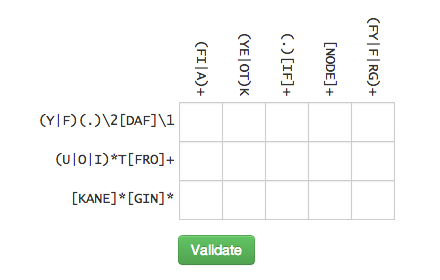
Fill in the grid so that each row and column matches the regular expression shown next to it. See this puzzle at regexcrossword.com
And if that isn’t too taxing, try tackling this monster from the 2013 MIT Mystery Hunt:
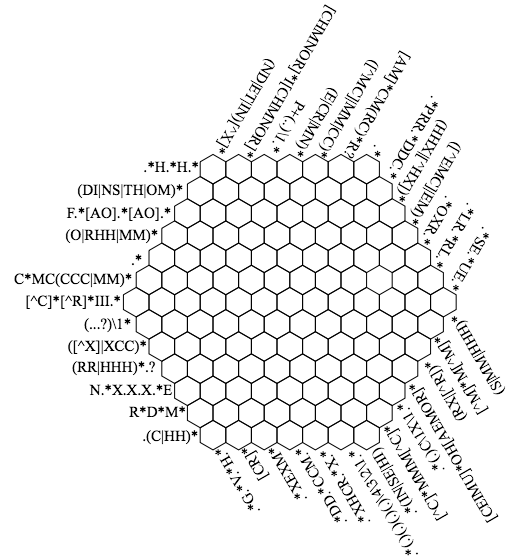
Regular expression puzzle from the 2013 MIT Mystery Hunt. Here’s the original PDF document. If you really need it, the solution is available.
(Link credit: kottke.org)
